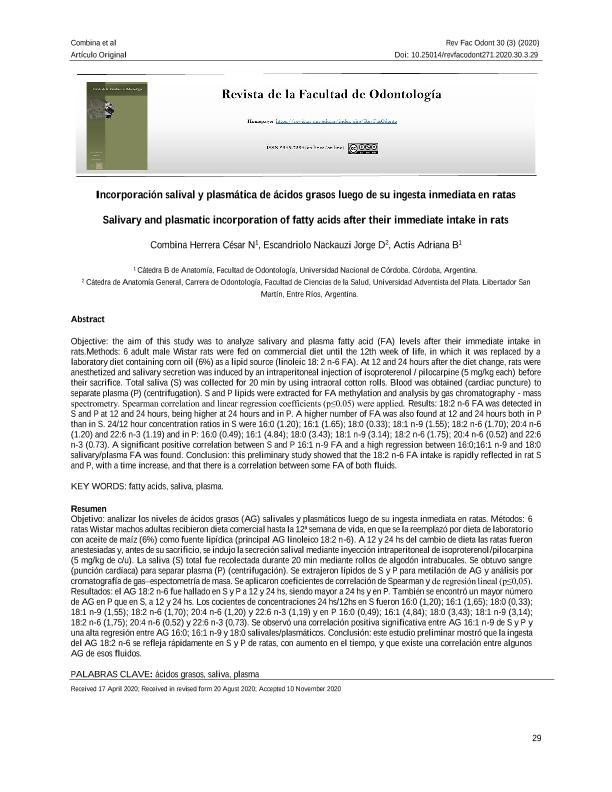Artículo
Objetivo: analizar los niveles de ácidos grasos (AG) salivales y plasmáticos luego de su ingesta inmediata en ratas. Métodos: 6 ratas Wistar machos adultas recibieron dieta comercial hasta la 12ª semana de vida, en que se la reemplazó por dieta de laboratorio con aceite de maíz (6%) como fuente lipídica (principal AG linoleico 18:2 n-6). A 12 y 24 hs del cambio de dieta las ratas fueron anestesiadas y, antes de su sacrificio, se indujo la secreción salival mediante inyección intraperitoneal de isoproterenol/pilocarpina (5 mg/kg de c/u). La saliva (S) total fue recolectada durante 20 min mediante rollos de algodón intrabucales. Se obtuvo sangre (punción cardíaca) para separar plasma (P) (centrifugación). Se extrajeron lípidos de S y P para metilación de AG y análisis por cromatografía de gas–espectometría de masa. Se aplicaron coeficientes de correlación de Spearman y de regresión lineal (p≤0,05). Resultados: el AG 18:2 n-6 fue hallado en S y P a 12 y 24 hs, siendo mayor a 24 hs y en P. También se encontró un mayor número de AG en P que en S, a 12 y 24 hs. Los cocientes de concentraciones 24 hs/12hs en S fueron 16:0 (1,20); 16:1 (1,65); 18:0 (0,33); 18:1 n-9 (1,55); 18:2 n-6 (1,70); 20:4 n-6 (1,20) y 22:6 n-3 (1,19) y en P 16:0 (0,49); 16:1 (4,84); 18:0 (3,43); 18:1 n-9 (3,14); 18:2 n-6 (1,75); 20:4 n-6 (0,52) y 22:6 n-3 (0,73). Se observó una correlación positiva significativa entre AG 16:1 n-9 de S y P y una alta regresión entre AG 16:0; 16:1 n-9 y 18:0 salivales/plasmáticos. Conclusión: este estudio preliminar mostró que la ingesta del AG 18:2 n-6 se refleja rápidamente en S y P de ratas, con aumento en el tiempo, y que existe una correlación entre algunos AG de esos fluidos. Objective: the aim of this study was to analyze salivary and plasma fatty acid (FA) levels after their immediate intake in rats.Methods: 6 adult male Wistar rats were fed on commercial diet until the 12th week of life, in which it was replaced by a laboratory diet containing corn oil (6%) as a lipid source (linoleic 18: 2 n-6 FA). At 12 and 24 hours after the diet change, rats were anesthetized and salivary secretion was induced by an intraperitoneal injection of isoproterenol / pilocarpine (5 mg/kg each) before their sacrifice. Total saliva (S) was collected for 20 min by using intraoral cotton rolls. Blood was obtained (cardiac puncture) to separate plasma (P) (centrifugation). S and P lipids were extracted for FA methylation and analysis by gas chromatography - mass spectrometry. Spearman correlation and linear regression coefficients (p≤0.05) were applied. Results: 18:2 n-6 FA was detected in S and P at 12 and 24 hours, being higher at 24 hours and in P. A higher number of FA was also found at 12 and 24 hours both in P than in S. 24/12 hour concentration ratios in S were 16:0 (1.20); 16:1 (1.65); 18:0 (0.33); 18:1 n-9 (1.55); 18:2 n-6 (1.70); 20:4 n-6 (1.20) and 22:6 n-3 (1.19) and in P: 16:0 (0.49); 16:1 (4.84); 18:0 (3.43); 18:1 n-9 (3.14); 18:2 n-6 (1.75); 20:4 n-6 (0.52) and 22:6 n-3 (0.73). A significant positive correlation between S and P 16:1 n-9 FA and a high regression between 16:0;16:1 n-9 and 18:0 salivary/plasma FA was found. Conclusion: this preliminary study showed that the 18:2 n-6 FA intake is rapidly reflected in rat S and P, with a time increase, and that there is a correlation between some FA of both fluids.
Incorporación salival y plasmática de ácidos grasos luego de su ingesta inmediata en ratas
Título:
Salivary and plasmatic incorporation of fatty acids after their immediate intake in rats
Fecha de publicación:
12/2020
Editorial:
Universidad Nacional de Córdoba. Facultad de Odontología
Revista:
Revista de la Facultad de Odontología
e-ISSN:
2545-7594
Idioma:
Español
Tipo de recurso:
Artículo publicado
Clasificación temática:
Resumen
Palabras clave:
ÁCIDOS GRASOS
,
SALIVA
,
PLASMA
Archivos asociados
Licencia
Identificadores
Colecciones
Articulos(INICSA)
Articulos de INSTITUTO DE INVESTIGACIONES EN CIENCIAS DE LA SALUD
Articulos de INSTITUTO DE INVESTIGACIONES EN CIENCIAS DE LA SALUD
Citación
Combina Herrera, César; Escandriolo Nackauzi, Jorge Dario; Actis, Adriana Beatriz; Incorporación salival y plasmática de ácidos grasos luego de su ingesta inmediata en ratas; Universidad Nacional de Córdoba. Facultad de Odontología; Revista de la Facultad de Odontología; 30; 3; 12-2020; 29-35
Compartir
Altmétricas




